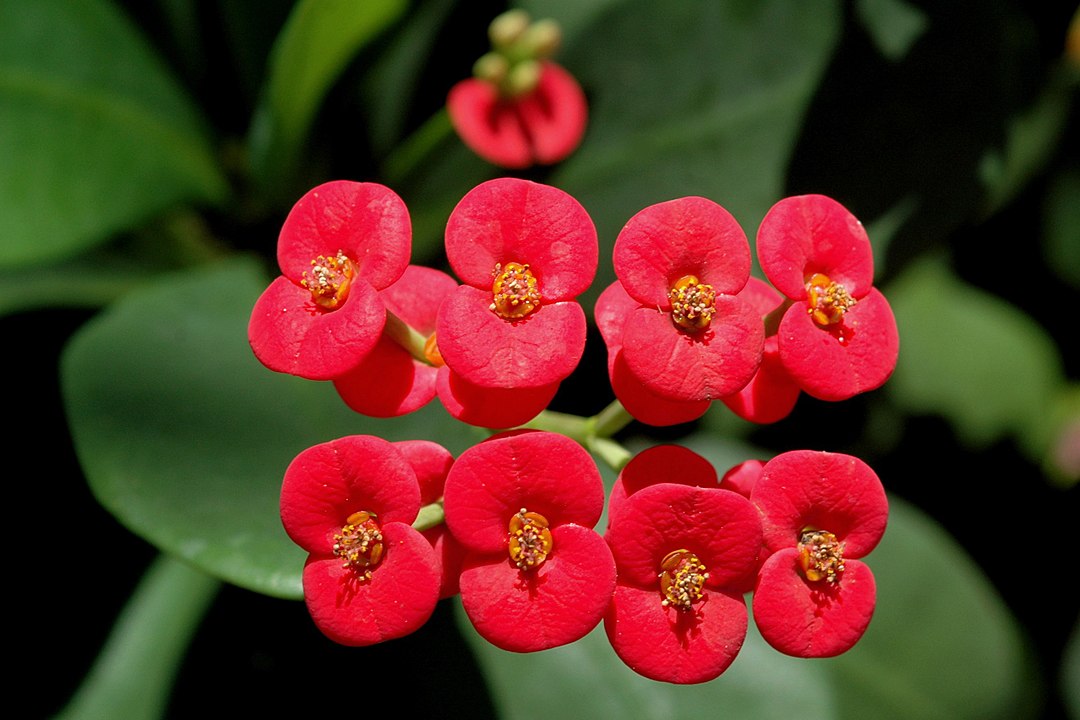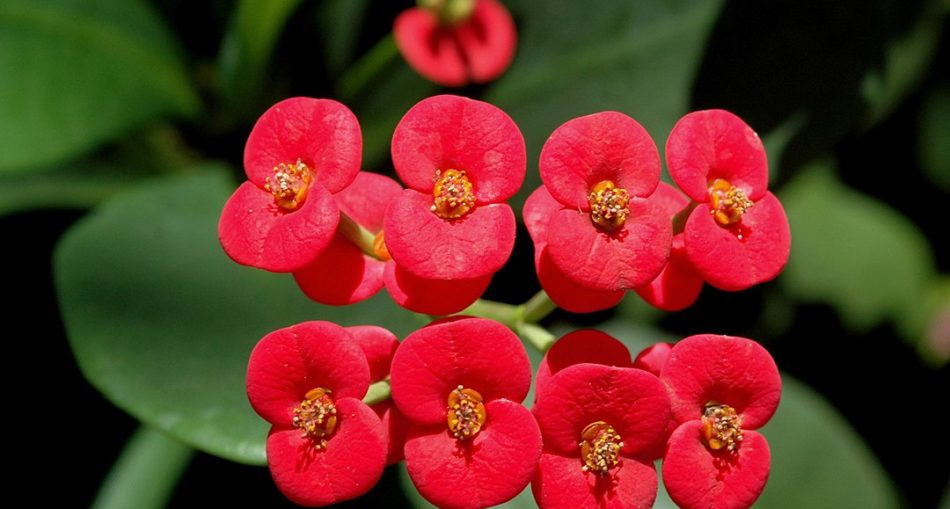Popularly known as by its common name the Crown of Thorn, Euphorbia milii is a gorgeous plant typically with brilliant red inflorescences growing in pairs. However, like most beautiful things, it can be dangerous. The Crown of Thorn plant is not a common one in Guyana and it only thrives in specific soil conditions around the world.
The scientific name of Crown of Thorns is Euphorbia milii but the plant is known by several other names such as Christ thorn, Christ plant, Christ thrown, epine du Christ,christusdorn, christusdoorn, schitterende, wolfsmelk, coroa-de-cristo in Brazil and Corona de Cristo in Latin America. The plant Euphorbia milii is believed to be used to make the crown worn by Christ, hence its numerous common names. Generally, Crown of Thorns are poisonous but some species may have medicinal and pest control qualities.
There is approximately eleven (11) subspecies of the Crown of Thorn species, including Euphorbia milii var. bevilaniensis, Euphorbia milii var. hislopii, Euphorbia milii var. imperatae, Euphorbia milii var. longifolia, Euphorbia milii var. milii, Euphorbia milii var. roseana, Euphorbia milii var. splendens, Euphorbia milii var. tananarivae, Euphorbia milii var. tenuispina, Euphorbia milii var. tulearensis and Euphorbia milii var. vulcanii.

Crown of Thorns -Photo By Ezra Katz – Own work, CC BY-SA 3.0, https://commons.wikimedia.org/w/index.php?curid=4004920
Origin of Crown of Thorns
The Crown of Thorns plant is native to Madagascar and the Philippines but has since spread to South America in Brazil and Guyana. The plant was introduced to France in 1821 by Baron Milius, the namesake of the plant (Euphorbia milii). Additionally, it is believed that the Crown of Thorns was introduced to the Middle East before the birth of Christ.
Description of Crown of Thorns
The Crown of Thorn is a succulent, woody shrub, reaching heights of about six (6) feet tall with dense, prickly stems. However in the United States, Crown of Thorns grow up to two (2) feet tall. The plants have slim spines about three (3) cm long which helps it to grow over other plants. Euphorbia milii has fleshy leaves, about three point five (3.5) cm in length, one point five (1.5) cm in width, green in colour and typically found growing near to new plant growth. Flowers grow in pairs of inflorescence, typically red, pink, yellow or white in colour. The Crown of Thorn flowers are about twelve (12) mm broad.
Interesting Tip
- The world tallest Crown of Thorn plant is claimed to be growing in Thailand.
- While the plant flowers all year, it especially flourish in spring and summer.
- Some people believe that the dark red colour of the bracts refers to Jesus’s drops of blood during crucification.
Scientific Classification of Crown of Thorns
- Kingdom: Plantae
- Clade: Tracheophytes
- Clade: Angiosperms
- Clade: Eudicots
- Clade: Rosids
- Order: Malpighiales
- Family: Euphorbiaceae
- Genus: Euphorbia
- Species: E. milii
Medicinal Uses of Crown of Thorns
- In South Brazil Euphorbia milii is used in folk medicine to treat warts.
- The plant is used to treat cancer and hepatitis in China.
Interesting Tip
- Most of the plant is poisonous including its bark, flowers, fruit, sap, seeds, stems, roots, fruits and leaves.
- The sap of Crown of Thorns is very toxic to domesticated animals, on the other hand, it is mildly poisonous for humans.
Other Uses Of Crown of Thorns
- Crown of Thorn plants are quite common ornamental houseplants since they thrive in warmer climates.
- While Crown of Thorns are also grown as hedges, they can easily be grown indoors as a houseplant.
- The plant is an effective molluscicide and can help in pest control of snails.
- Additionally, plant extracts from the Crown of Thorns are used to prevent parasite infection.
- Crown of Thorn plants were used to stun fishes and for arrow poisons.
About Crown of Thorns
The Crown of Thorn is a captivating flower but has some toxic qualities. The plant is believed to have been used to make the “crown of thorns” which is significant in Christianity. The plant has numerous subspecies with blooms varying from red to white. The Crown of Thorn plant makes great outdoor ornamental plants and hedges, but remember to be careful while handling them.
Article References
- https://en.wikipedia.org/wiki/Euphorbia_milii
- https://dengarden.com/gardening/Crown-of-Thorns-Plant#:~:text=The%20sap%20in%20some%20species,can%20be%20fatal%20to%20fish.
- https://plants.ces.ncsu.edu/plants/euphorbia-milii/
- https://www.imedpub.com/articles/phytochemical-screening-on-euphorbia-miliired-flowers–isolation-of-terpenoidsflavone-and-phenols.php?aid=11009#:~:text=Euphorbia%20milii%20widely%20used%20in,curb%20the%20spread%20of%20schistosomiasis.
- http://www.missouribotanicalgarden.org/PlantFinder/PlantFinderDetails.aspx?kempercode=b633
- https://www.researchgate.net/publication/331385737_Euphorbia_Characterization_and_Uses







